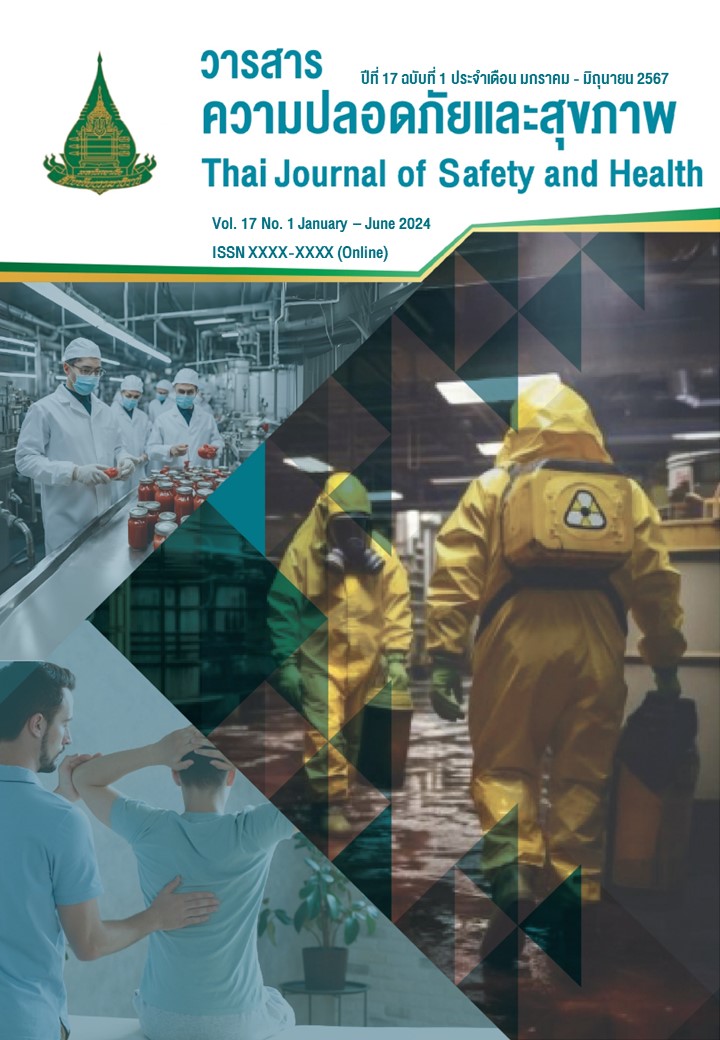การเปรียบเทียบความเข้มข้นของชื้อจุลินทรีย์ในอากาศระหว่างห้องพัดลมและห้องแอร์ในศูนย์พัฒนาเด็กเล็ก จังหวัดเลย
Main Article Content
บทคัดย่อ
การศึกษานี้มีวัตถุประสงค์ (1) เพื่อเปรียบเทียบความเข้มข้นของเชื้อจุลินทรีย์ในอากาศระหว่างห้องพัดลมกับห้องแอร์ของศูนย์พัฒนาเด็กเล็ก จังหวัดเลย (2) เพื่อเปรียบเทียบความเข้มข้นของเชื้อจุลินทรีย์ในอากาศระหว่างพื้นที่เก็บตัวอย่างของศูนย์พัฒนาเด็กเล็ก จังหวัดเลย โดยทำการสุ่มตัวอย่างแบบกลุ่ม (Cluster sampling) 2 ศูนย์พัฒนาเด็กเล็ก/พื้นที่ ในเขตพื้นที่ 3 อำเภอ โดยใช้เครื่องมือมาตรฐาน Bio-Stage Impactor สำหรับเก็บตัวอย่างเชื้อจุลินทรีย์ในอากาศทั้งหมด 164 ตัวอย่าง
ผลการศึกษาพบว่าความเข้มข้นเฉลี่ยของเชื้อแบคทีเรียในอากาศและเชื้อราในอากาศภายในห้อง เท่ากับ 41.09±21.13 cfu/m3 และ 20.83±23.25 cfu/m3 ตามลำดับ ส่วนความเข้มข้นเฉลี่ยของเชื้อแบคทีเรียในอากาศและเชื้อราในอากาศภายนอกห้อง เท่ากับ 35.18±28.76 cfu/m3 และ 11.45±9.78 cfu/m3 ตามลำดับ สัดส่วนความเข้มข้นของเชื้อแบคทีเรียในอากาศและเชื้อราในอากาศภายในห้องต่อภายนอกห้อง (I/O) เท่ากับ 1.17 และ 1.07 ตามลำดับ ทั้งนี้พบว่าค่ามัธยฐานของความเข้มข้นของเชื้อแบคทีเรียในอากาศของศูนย์พัฒนาเด็กเล็กที่เป็นห้องพัดลมและห้องแอร์เท่ากับ 47.46 cfu/m3 (95% ค่ามัธยฐาน 40.80 ถึง 65.85) และ 28.71 cfu/m3 (95% ค่ามัธยฐาน 21.93 ถึง 35.61) ตามลำดับ เมื่อเปรียบเทียบความเข้มข้นของเชื้อแบคทีเรียในอากาศระหว่างห้องแอร์กับห้องพัดลมมีความแตกต่างกันอย่างมีนัยสำคัญทางสถิติ p-value < 0.001 ดังนั้นผลการวิจัยนำไปสู่การติดตามและวางแผนการดำเนินงานด้านสิ่งแวดล้อมในศูนย์พัฒนาเด็กเล็กเพื่อลดจุลินทรีย์ในอากาศต่อไป
Article Details

อนุญาตภายใต้เงื่อนไข Creative Commons Attribution-NonCommercial-NoDerivatives 4.0 International License.
Journal of Safety and Health is licensed under a Creative Commons Attribution-NonCommercial-NoDerivatives 4.0 International (CC BY-NC-ND 4.0) licence, unless otherwise stated.
เอกสารอ้างอิง
กระทรวงสาธารณสุข, กรมอนามัย, สำนักอนามัยสิ่งแวดล้อม. (2559). คู่มือการปฏิบัติงานเพื่อการตรวจประเมินคุณภาพอากาศภายในอาคาร. กระทรวงสาธารณสุข.
รจฤดี โชติกาวินทร์. (2559). คุณภาพอากาศทางจุลินทรีย์ในสถานศึกษาปฐมวัย. วารสารมหาวิทยาลัยทักษิณ, 19(1), 84-95.
Agarwal, S., Mandal, P., Majumdar, D., Aggarwal, S. G., & Srivastava, A. (2017). Characterization of Bioaerosols and their Relation with OC, EC and Carbonyl VOCs at a Busy Roadside Restaurants-Cluster in New Delhi. Aerosol and Air Quality Research, 16(2), 3198-3211. https://doi.org/10.4209/aaqr.2016.01.0043
Andualem, Z., Gizaw, Z., Bogale, L., & Dagne, H. (2019). Indoor bacterial load and its correlation to physical indoor air quality parameters in public primary schools. Multidisciplinary Respiratory Medicine, 14(2), 1-7. https://doi.org/10.1186/s40248-018-0167-y
Aydogdu H., Asan A., & Tatman, O. M. (2010). Indoor and outdoor airborne bacteria in child day-care centers in Edirne City (Turkey), seasonal distribution and influence of meteorological factors. Environ Monit Assess, 164, 53-66. https://doi.org/10.1007/s10661-009-0874-0
Balasubramanian, R., Nainar, P., & Rajasekar, A. (2012). Airborne bacteria, fungi, and endotoxin levels in residential microenvironments: a case study. Aerobiologia, 28(3), 375-390. https://doi.org/10.1007/s10453-011-9242-y
Bragoszewska, E., Mainka, A., & Pastuszka, J. (2016). Bacterial and Fungal Aerosols in Rural Nursery Schools in Southern Poland. Atmosphere, 7(142), 1-16. https://doi.org/10.3390/atmos7110142
Cho, E. M., Hong, H. J., Park, S. H., Yoon, D. K., Nam Goung, S J., & Lee, C. M. (2019). Distribution and Influencing Factors of Airborne Bacteria in Public Facilities Used by Pollution-Sensitive Population: A Meta-Analysis. Int J Environ Res Public Health, 16(1483), 1-12. https://doi.org/10.3390/ijerph16091483
Choomsri, P., Suphim, B., Chalamat, M., Panpethch, O., Jinapon, C., & Laoraksawong, P. (2023). Factors Correlated with the Concentration of Airborne Microbes in Childcare Center, Loei, Thailand. Journal of Southwest Jiaotong University, 58(4), 334-343. https://doi.org/10.35741/issn.0258-2724.58.4.27
Ding, E., Zhang, D., & Bluyssen, P. M. (2022). Ventilation regimes of school classrooms against airborne transmission of infectious respiratory droplets: A review. Building and Environment, 20(7), 108484. https://doi.org/10.1016/j.buildenv.2021.108484
Felgueiras, F., Mourao, Z., Fernandes, E. de O., & Gabriel, M. F. (2022). Airborne bacterial and fungal concentrations and fungal diversity in bedrooms of infant twins under 1 year of age living in Porto. Environmental Research, 206(2022), 112568. https://doi.org/10.1016/j.envres.2021.112568
Harbizadeh, A., Mirzaee, S. A., Khosravi, A. D., Shoushtari, F. S., Goodarzi, H., Alavi, N., Ankalia, K. A., Rada, H. D., Malekia, H., & Goudarzi, G. (2019). Indoor and outdoor airborne bacterial air quality in day-care centers (DCCs) in greater Ahvaz, Iran. Atmospheric Environment, 216(2016), 116927. https://doi.org/10.1016/j.atmosenv.2019.116927
Hsu, Y-C, Kung, P-Y, Wu, T-N, & Shen, Y-H. (2012). Characterization of Indoor-Air Bioaerosols in Southern Taiwan. Aerosol and Air Quality Research, 12(4), 651-661. https://doi.org/10.4209/aaqr.2012.03.0070
Huang, C., Liu, W., Hu, Y., Zou, Z., Zhao, Z., Shen, L., Weschler, L. B., & Sundell, J. (2015). Updated prevalences of asthma, allergy, and airway symptoms, and a systematic review of trends over time for childhood asthma in Shanghai. PLoS One, 10(4), 1-8. https://doi.org/10.1371/journal.pone.0121577
Hwang, S. H., Kim, I. S., & Park, W. M. (2016). Concentrations of PM10 and airborne bacteria in daycare centers in Seoul relative to indoor environmental factors and daycare center characteristics. Air Quality, Atmosphere & Health, 10(2), 139-145. https://doi.org/10.1007/s11869-016-0423-2
Liu, G., Xiao, M., Zhang, X., Gal, C., Chen, X., Liu, L., Pan, S., Wu, J., Tang, L., & Clements-Croome, D. (2017). A review of air filtration technologies for sustainable and healthy building ventilation. Sustainable Cities and Society, 32(2017), 375-396. https://doi.org/10.1016/j.scs.2017.04.011
Liu, Z., Li, A., Hu, Z., & Sun, H. (2014). Study on the potential relationships between indoor culturable fungi, particle load and children respiratory health in Xi'an, China. Building and Environment, 80(2014), 105-114. https://doi.org/10.1016/j.buildenv.2014.05.029
Mirhoseini, S. H., Ariyan, F., & Mohammadi, S. (2019). Quantitative and Qualitative Monitoring of Airborne Bacteria and Fungi and Their Relationship with Environmental Parameters in Two Selected Primary Schools. Journal of Arak University of Medical Sciences, 22(6), 242-251. https://doi.org/10.32598/JAMS.22.6.5931.1
Mirhoseini, S. H, Dehdashti, F. A., & Mohammadi, S. (2020). A Comparative Evaluation of Bioaerosol Emission and Particle Matter Concentration in Urban Primary Schools. International Journal of Environmental Health Engineering, 2020, 1-6. https://doi.org/10.4103/ijehe.ijehe_30_20
Pipat, L., Yuwadee, R., & Pisit, V. (2012). Microbial Counts and Particulate Matter Levels in Indoor Air Samples Collected from a Child Home-Care Center in Bangkok, Thailand. J Med Assoc Thai, 95(6), 161-168.
World Health Organization. (2029). WHO guidelines for indoor air quality: dampness and mould. WHO Regional Office for Europe.


